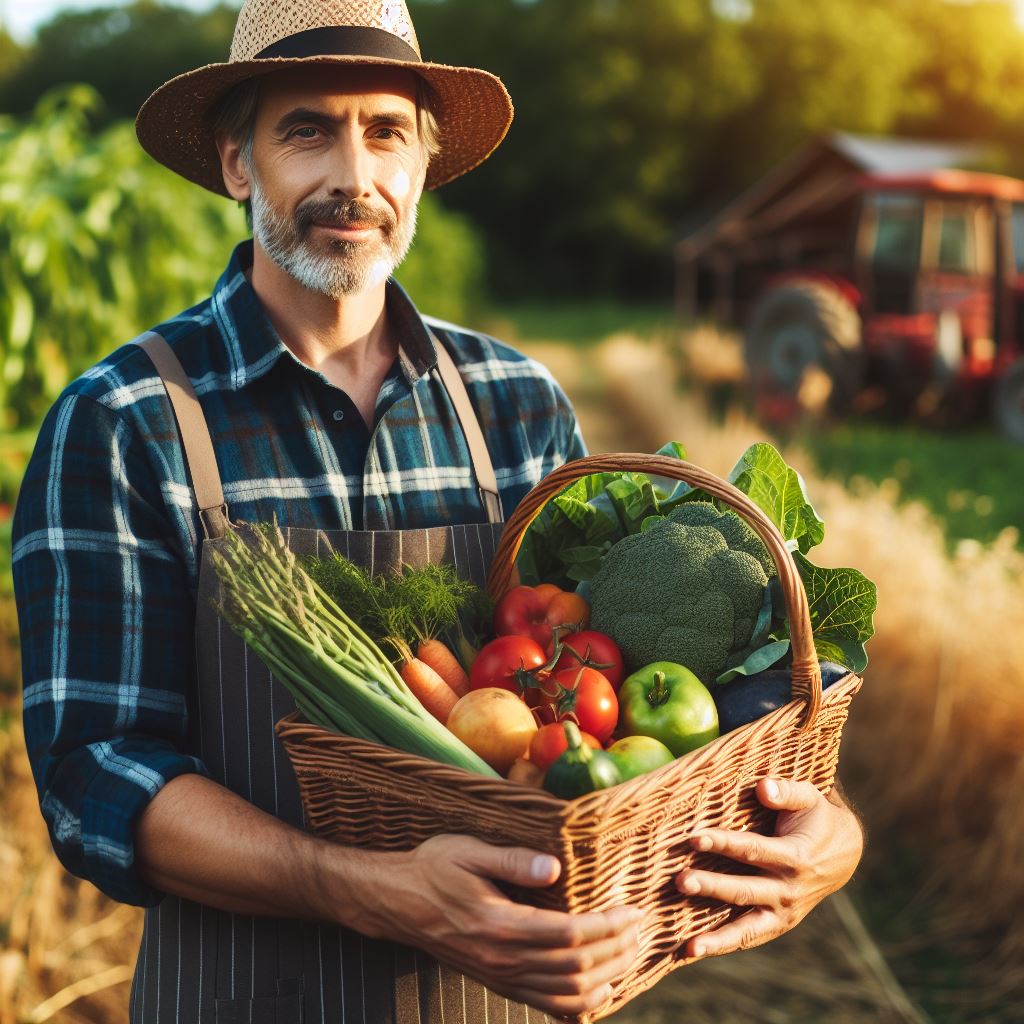Introduction
The importance of risk reduction in farming
Risk reduction is of utmost importance in farming as it helps protect farmers from potential losses and uncertainties.
Additionally, the incorporation of technology plays a significant role in enhancing risk reduction strategies.
This blog post aims to explore various technologies that can aid in farm risk reduction.
Farming is an industry filled with risks, ranging from natural disasters to disease outbreaks, which can lead to devastating consequences for farmers.
However, by implementing effective risk reduction measures, farmers can minimize these potential losses and protect their livelihoods.
The significance of technology in enhancing risk reduction
Technology has revolutionized the agriculture sector, offering innovative solutions to mitigate risks on farms.
With the advent of advanced data analytics, farmers can now accurately predict weather patterns and climate changes, enabling them to take proactive measures to protect crops and livestock.
One example of technology’s significance in risk reduction is the use of remote sensing tools such as satellites and drones.
These tools provide farmers with real-time data on crop health, nutrient deficiencies, and pest infestations.
By identifying potential problems early on, farmers can take immediate action to prevent further damage.
Furthermore, the integration of artificial intelligence (AI) enables farmers to efficiently manage their operations and reduce risk.
AI-powered systems can analyze vast amounts of data to optimize irrigation schedules, detect disease outbreaks, and even automate tasks like harvesting.
In essence, technology plays a vital role in enhancing risk reduction in farming. By leveraging advanced tools and systems, farmers can better protect their crops, livestock, and overall farming practices.
Thesis statement
This blog post will further explore various technologies that contribute to farm risk reduction, offering insights and recommendations for farmers to integrate them into their operations.
Weather Monitoring Technology
Weather’s influence on farming risks
Weather plays a crucial role in determining the level of risks associated with farming activities.
Transform Your Agribusiness
Unlock your farm's potential with expert advice tailored to your needs. Get actionable steps that drive real results.
Get StartedUnfavorable weather conditions such as drought, heavy rains, frost, and extreme temperatures can significantly impact crop growth and yield.
Introduction to weather monitoring technology
Weather monitoring technology encompasses an array of tools and techniques used to gather meteorological data, which helps farmers make informed decisions about their farming operations.
The benefits of using weather monitoring technology
Timely weather alerts for potential risks
Weather monitoring technology provides timely alerts about upcoming weather events, allowing farmers to prepare and mitigate potential risks.
This early warning system helps farmers take preventive measures to protect their crops, livestock, and infrastructure from adverse weather conditions.
Accurate data for better decision-making
By utilizing weather monitoring technology, farmers gain access to accurate and real-time weather data.
This data allows them to make precise decisions regarding the timing of planting, irrigation, pest control, and harvesting.
As a result, farmers can improve the overall efficiency of their farming operations and optimize crop yields.
Improved planning and resource allocation
With weather monitoring technology, farmers can effectively plan their farming activities by incorporating weather forecasts into their decision-making processes.
This enables them to allocate resources such as labor, machinery, and fertilizers more efficiently.
By aligning their farming operations with the weather conditions, farmers can minimize costs and maximize productivity.
Weather monitoring technology also helps farmers manage their resources sustainably.
For example, by monitoring rainfall levels and soil moisture content, farmers can implement irrigation systems only when necessary, reducing water waste and conserving this precious resource.
In addition, the use of weather monitoring technology facilitates better risk assessment.
Farmers can analyze historical weather data to identify patterns and trends in their local climate, allowing them to anticipate potential long-term risks such as changing precipitation patterns or increasing temperature variations.
Armed with this knowledge, farmers can adapt their farming practices and adopt appropriate mitigation strategies to cope with future challenges.
Overall, weather monitoring technology empowers farmers with the information they need to make informed decisions and mitigate risks.
By relying on accurate weather data and alerts, farmers can optimize their farming operations, minimize losses caused by adverse weather, and ultimately enhance the sustainability and profitability of their agricultural activities.
Read: Smart Farming: A Future View
Precision Agriculture Systems
Precision agriculture systems have revolutionized farming practices by leveraging advanced technology and data-driven decision-making.
These systems provide farmers with valuable insights into their fields, enabling them to optimize crop production while reducing risks.
Definition of precision agriculture
Precision agriculture refers to the use of technology and data analysis to optimize farming practices and reduce risks.
How precision agriculture systems reduce risks
The risk reduction benefits of precision agriculture are substantial.
Optimized use of fertilizers and pesticides not only saves costs but also reduces the risk of soil contamination and water pollution.
By applying these inputs only where necessary, precision agriculture minimizes environmental harm.
Showcase Your Farming Business
Publish your professional farming services profile on our blog for a one-time fee of $200 and reach a dedicated audience of farmers and agribusiness owners.
Publish Your ProfilePrecision agriculture systems enable farmers to make informed decisions based on accurate data, reducing risks such as crop failure, pest infestation, and resource wastage.
Different components of precision agriculture systems
One of the key components of precision agriculture is remote sensing and satellite imagery.
By capturing data on crop health, farmers can identify areas of concern and take necessary action promptly. This helps in early detection of pest infestations, diseases, or nutrient deficiencies, minimizing the risk of crop failure.
Furthermore, GPS and guidance systems play a crucial role in precision agriculture.
Farmers can accurately navigate their machinery, ensuring precise planting, spraying, and harvesting.
This not only reduces the risk of crop damage but also maximizes the efficient use of resources, such as seeds and fertilizers.
Variable rate technology is another vital component of precision agriculture systems.
It allows farmers to adjust input application rates based on specific field conditions.
By supplying the right amount of water, fertilizers, and pesticides in specific regions of the field, farmers can optimize resource usage, reducing costs and minimizing environmental impact.
Illustrate the risk reduction benefits of precision agriculture
Precision agriculture systems also contribute to increased crop yield and quality.
By effectively managing inputs based on field conditions, such as varying water needs or soil composition, farmers can maximize the productivity of their crops.
This ultimately leads to higher profitability and better-quality produce.
Moreover, precision agriculture helps minimize soil erosion and nutrient runoff.
By precisely targeting resource application, the risk of excess nutrients running off into water bodies is reduced.
This not only helps in soil conservation but also protects water sources from contamination.
In general, precision agriculture systems have revolutionized the farming industry by reducing risks and optimizing resource usage.
Through the integration of remote sensing, GPS, and variable rate technology, farmers can make informed decisions to achieve higher yields, better quality produce, and environmental sustainability.
This technology-driven approach sets the stage for a more efficient and sustainable future in farming.
Read: Investment Tips in Agriculture
Learn More: Global Branding for Farm Products
Livestock Monitoring Technology
Highlight the risks associated with livestock farming
Livestock farming poses various risks such as disease outbreaks, reproductive problems, and financial losses.
The inability to detect early signs of diseases can lead to widespread outbreaks and significant economic losses.
Reproductive issues such as low conception rates and high mortality rates can impact the productivity and profitability of livestock farming.
Unpredictable weather conditions, natural disasters, and livestock theft also contribute to the risks involved in this industry.
Introduction to livestock monitoring technology
Livestock monitoring technology refers to the use of advanced tools and systems to track and analyze the health, behavior, and reproduction of animals.
These technologies provide farmers with real-time data, enabling them to make informed decisions and mitigate risks effectively.
With the help of sensors, wearable devices, and data analytics, livestock farmers can monitor their animals remotely and collect valuable insights.
The benefits of using livestock monitoring technology
Early detection of health issues or diseases
By utilizing livestock monitoring technology, farmers can detect health issues and diseases at early stages.
Sensors can monitor vital signs, such as body temperature and heart rate, providing alerts for any abnormalities.
This early detection allows for timely intervention and appropriate treatment, reducing the impact of the disease on the entire herd.
Real-time tracking and behavior analysis
Livestock monitoring technology enables real-time tracking of animals, helping farmers keep track of their location, movement, and behavior.
This tracking system can detect anomalies in behavior, indicating distress, aggression, or signs of labor.
Analyzing these patterns can help identify potential issues and improve animal welfare, leading to better farm management practices.
Enhanced efficiency in breeding and reproduction management
By deploying livestock monitoring technology, farmers can maximize the efficiency of breeding and reproduction management.
Sensors can accurately detect heat cycles, allowing for precise artificial insemination and improving breeding success rates.
Furthermore, monitoring systems can notify farmers about optimal breeding times, ensuring better genetic selection and higher quality offspring.
Livestock monitoring technology offers numerous advantages for farmers, improving overall farm productivity and reducing risks.
The early detection of health issues and diseases minimizes losses and prevents the spread of infections.
Real-time tracking and behavior analysis help in predicting and managing potential issues promptly.
Efficient breeding and reproduction management lead to healthier animals and improved genetic selection.
Showcase Your Farming Business
Publish your professional farming services profile on our blog for a one-time fee of $200 and reach a dedicated audience of farmers and agribusiness owners.
Publish Your ProfileIn conclusion, the integration of livestock monitoring technology in farming practices has revolutionized risk reduction.
Farmers can now proactively manage and mitigate the risks associated with livestock farming.
The ability to detect health issues early, track animals in real-time, and efficiently manage breeding and reproduction enhances overall farm efficiency.
Investing in livestock monitoring technology not only safeguards the welfare of animals but also ensures the long-term sustainability and profitability of livestock farming.
Read: Innovative Agri Business Models

Learn More: 2024’s Guide to Agri Financial Planning
Data Analytics and Predictive Modeling
Importance of Data in Risk Reduction
Data plays a crucial role in mitigating risks in farming operations.
It provides valuable insights into the factors that contribute to potential hazards.
By analyzing data, farmers can anticipate and minimize various risks, ensuring better productivity and profitability.
Introduction to Data Analytics and Predictive Modeling in Farming
Data analytics and predictive modeling are powerful tools that harness the potential of data.
They enable farmers to extract meaningful information from vast amounts of data collected from various sources.
This information can be used to make informed decisions and develop effective risk reduction strategies.
Benefits of Using Data Analytics and Predictive Modeling
Using data analytics and predictive modeling techniques in farming offers several advantages:
Identification of patterns and trends for informed decision-making
Data analytics allow farmers to identify patterns and trends in their operations.
This analysis provides essential insights into the factors that impact productivity and risk levels.
By understanding these patterns, farmers can make informed decisions and take necessary actions to mitigate risks effectively.
Early identification of potential risks and proactive measures
Predictive modeling helps farmers identify potential risks before they even occur.
By analyzing historical data and applying predictive algorithms, farmers can recognize patterns associated with specific risks.
This early detection enables them to take proactive measures to prevent or minimize the impact of these risks on their farming operations.
Improved resource allocation and cost optimization
Data analytics and predictive modeling also optimize resource allocation and reduce costs.
By analyzing data, farmers can determine the most efficient use of resources such as water, fertilizers, and pesticides.
This optimization minimizes waste, reduces expenses, and enhances overall profitability.
In summary, the use of data analytics and predictive modeling in agriculture has become increasingly important for risk reduction.
Thanks to these techniques, farmers can access crucial insights and make informed decisions to mitigate risks effectively.
Data analytics allows them to identify patterns and trends, enabling proactive measures to minimize potential risks.
Furthermore, predictive modeling aids in early risk detection, preventing or reducing the impact of hazards on farming operations.
Lastly, these techniques improve resource allocation, optimizing costs and enhancing productivity.
Embracing data-driven approaches empowers farmers to navigate the complex landscape of risks and uncertainties, ensuring a sustainable and profitable future.
Recap the discussed technologies for farm risk reduction
Read: Risk Management in Farming
Conclusion
Recap the discussed technologies for farm risk reduction
In this blog post, we discussed several technologies that can be employed for farm risk reduction.
The significance of integrating technology into farming practices
These include precision agriculture, drones, and data analytics.
Integrating technology into farming optimizes efficiency, enhances precision, and improves yield.
Innovations like precision agriculture, drones, and smart sensors enable real-time monitoring, resource management, and data-driven decision-making.
This not only boosts productivity but also promotes sustainability, making farming more resilient and adaptive to evolving global challenges.
Final thoughts on the role of technology in achieving sustainable and resilient agriculture.
It is essential to recognize the significance of integrating technology into farming practices for effective risk management.
This can enhance productivity and profitability.
Technology plays a crucial role in achieving sustainable and resilient agriculture.
It provides farmers with valuable insights and tools to mitigate risks and optimize operations.




